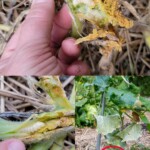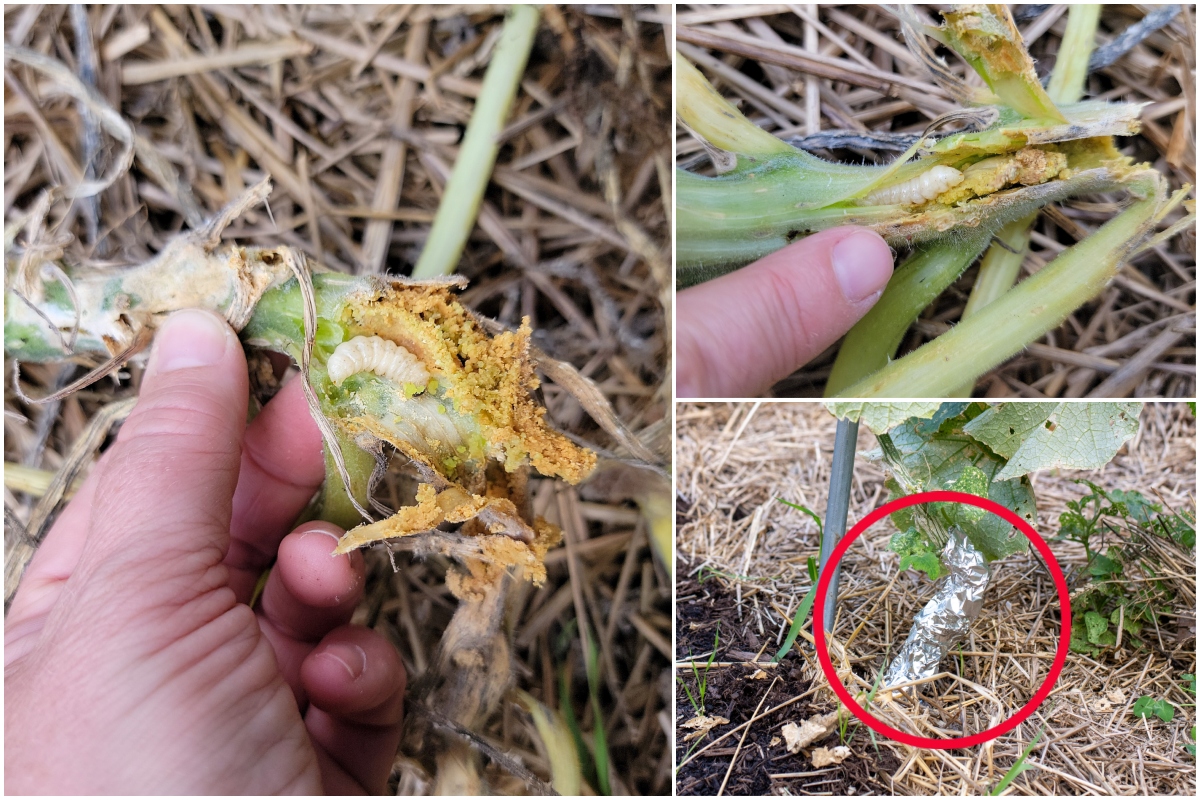
I’m going to begin this article with a rather bold statement, and it will probably upset many gardeners.
Squash bugs aren’t killing your squash plants.
Excuse me? What did you say?
I said squash bugs aren’t killing your squash plants.
Let me get this straight, Tracey. You’re telling me the pathetic-looking squash in my garden, you know, the wilting, yellow dying ones with the crusty brown leaves, are not the result of the hundreds of squash bugs crawling all over them?
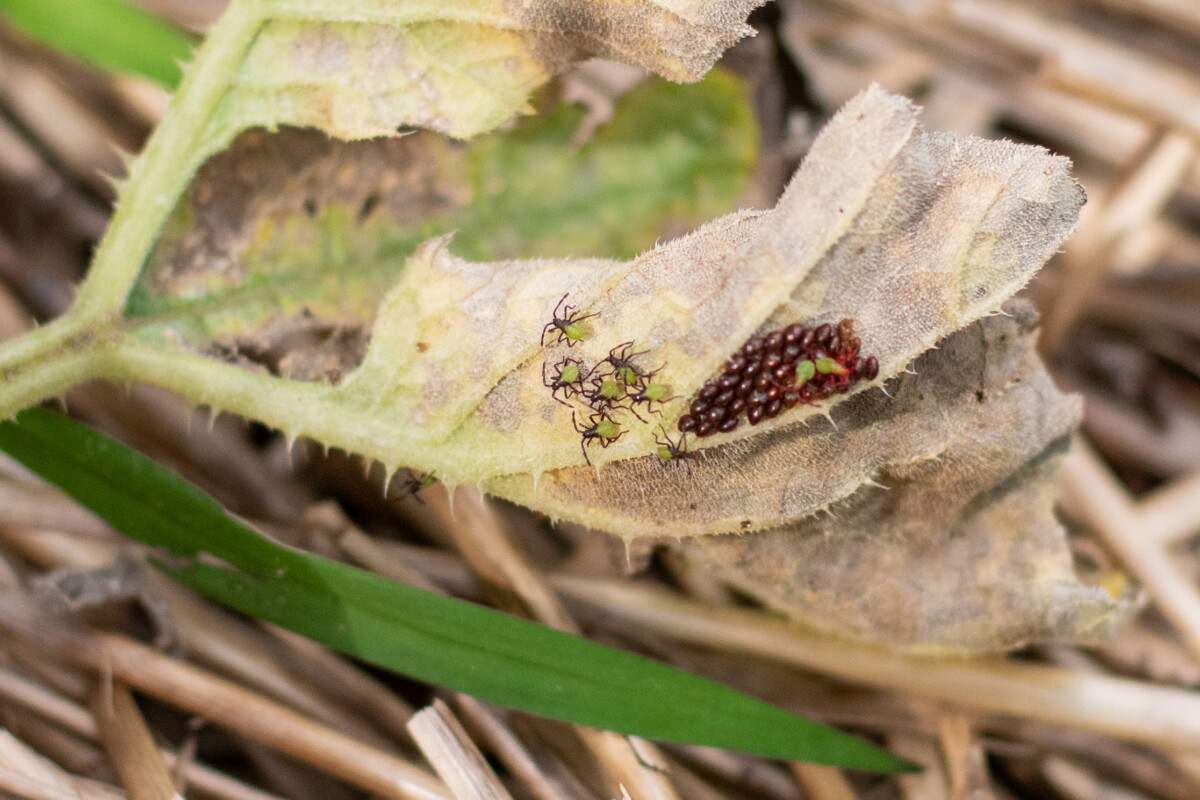
That is correct, my friend.
I hate to break it to you, but it’s highly unlikely squash bugs have murdered your plants, at least not by themselves. It’s almost certain that your squash is also being attacked by the silent, sneaky squash bug you can’t see.
Squash vine borers.
Yup, squash vine borers are brilliant pests, causing visible signs of disease and decay yet remaining out of sight. Meanwhile, squash bugs have been taking the rap for the death and destruction of cucurbits for ages.
Rethink How You Diagnose Ailing Squash
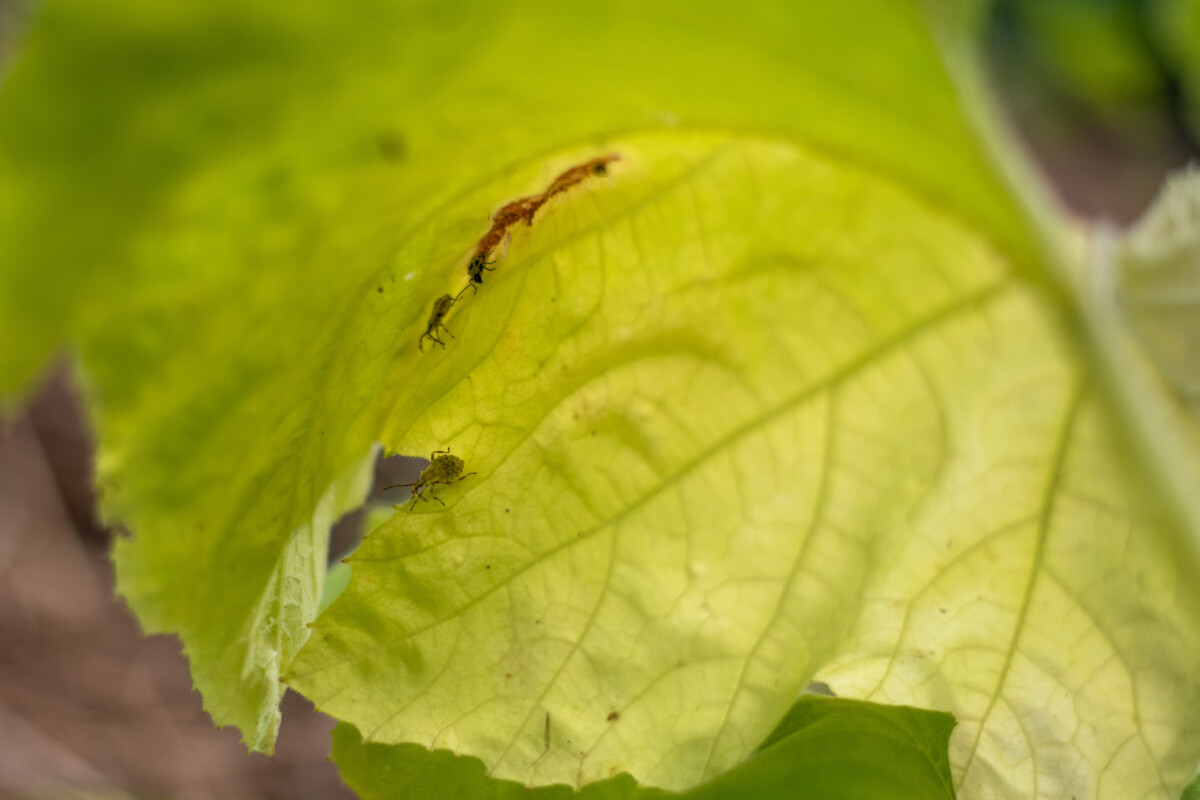
The problem is that squash bugs are so prevalent that it’s rare to find a plant infested with squash borers that doesn’t have squash bugs, too. And because the squash bugs are what we see, we immediately link the damage from the borers to the bugs.
So, we spray our squash with neem, pick off the squash bugs and remove leaves with eggs on them. Often, the plant dies anyway, and we chalk it up to not dealing with the squash bugs quickly enough or too big of an infestation.
This is rarely the case.
Don’t get me wrong; squash bugs can damage squash plants, but unless the plant is already weakened by disease or is a new transplant, squash bugs alone will rarely do enough damage to kill a squash plant. It’s usually the one-two punch of squash vine borers and squash bugs, and only one of the two needs our attention.
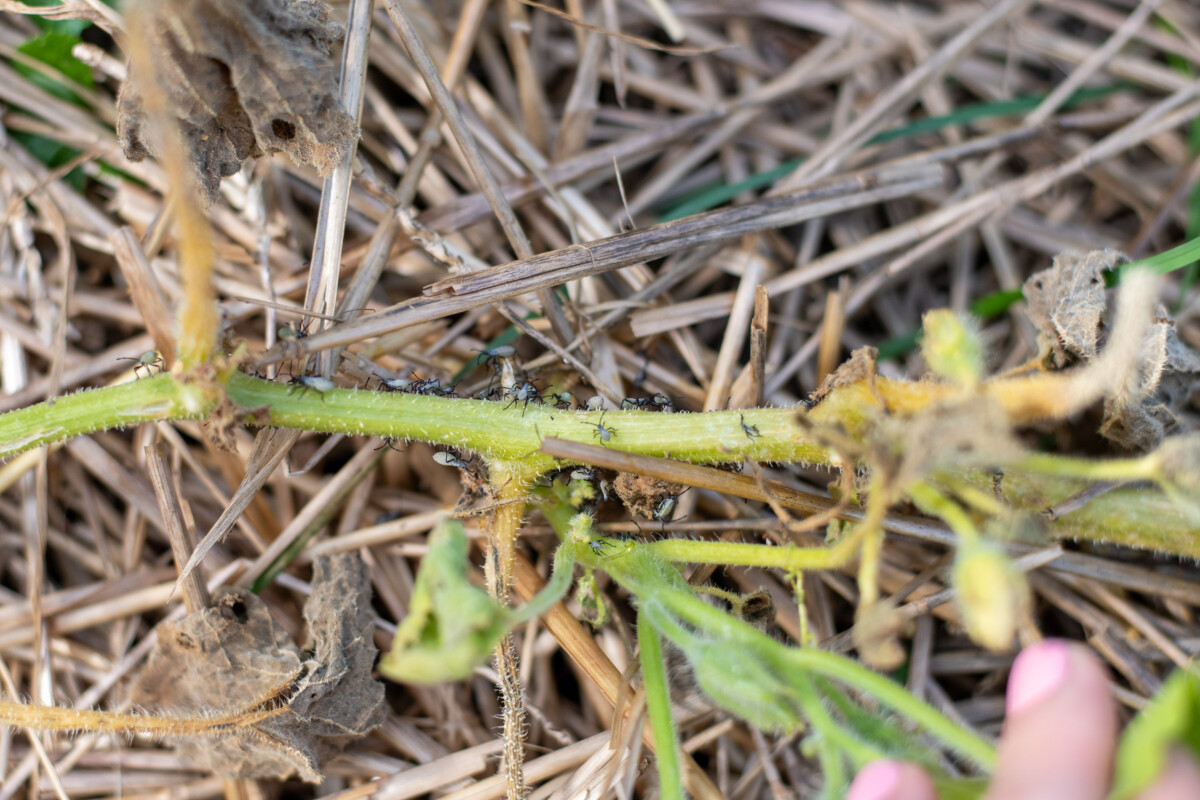
Nine times out of ten, we’ve missed the real problem, which is now lying dormant in our soil, ready to ruin next year’s squash harvest. Until today.
I want you to repeat after me.
When my squash plants are horrors, it’s probably squash borers.
Sorry, it’s hard to find something that rhymes with borer.
How about this?
When my squash plants are ailing, must be squash borers prevailing.
Okay, I’m going to stop now. You get the idea.
From now on, at the first sign of decline in your cucurbits, squash vine borers are the first thing you should look for. Yes, even before you reach for the watering can. Remember, squash is naturally drought resistant.
Squash Vine Borer – Getting to Know Your Squash’s Worst Nightmare
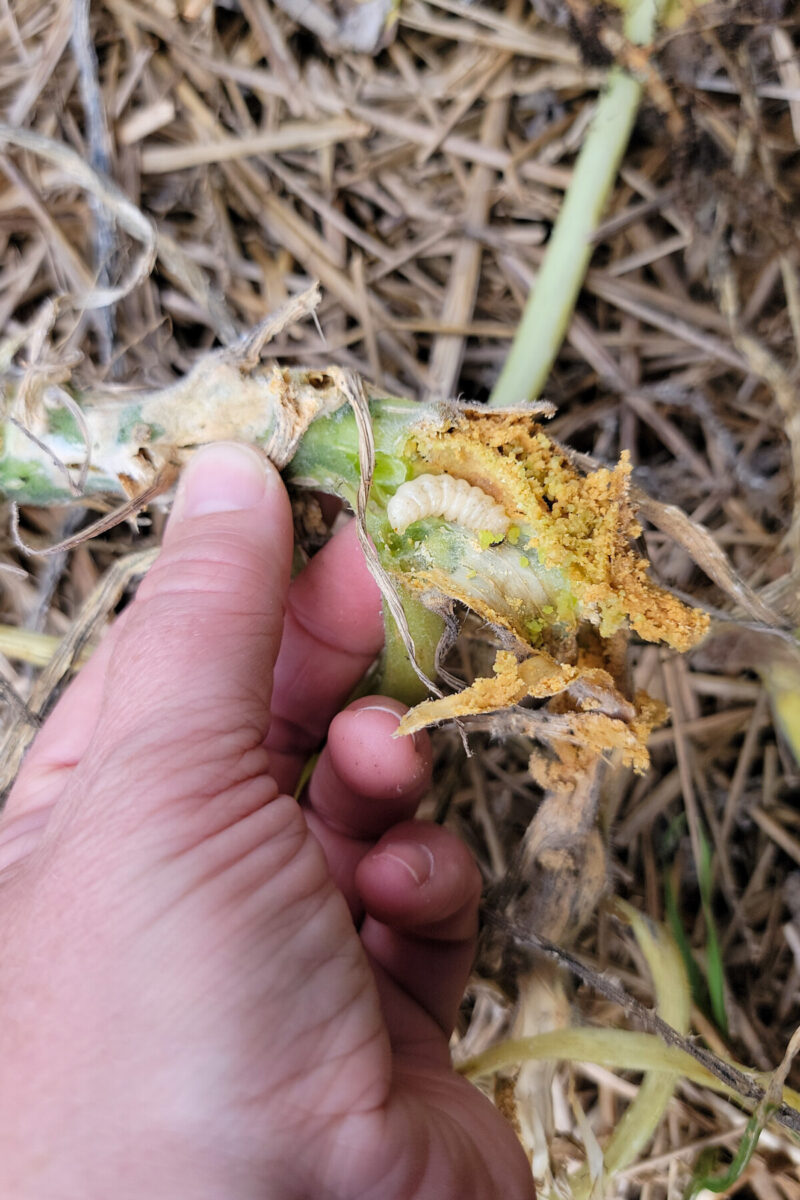
The squash vine borer (Melittia cucurbitae) is an all-too-common pest native to North America, found throughout the United States and parts of Canada. It affects plants in the cucurbit family — squash, zucchini, pumpkin, cucumber, and melons. Borers cause significant damage to the vascular system, ultimately killing the plant if left unchecked.
Life Cycle
Keep in mind that the actual timing of each stage depends on where you live. Also, if you live in the southern half of the United States, you could be dealing with two generations of squash vine borer per year as the moths emerge much earlier in the season.
If squash vine borers are a problem, I recommend reaching out to your county extension office to get more detailed information on when they emerge in your area and how long the female moths are actively laying eggs.
Egg Stage:
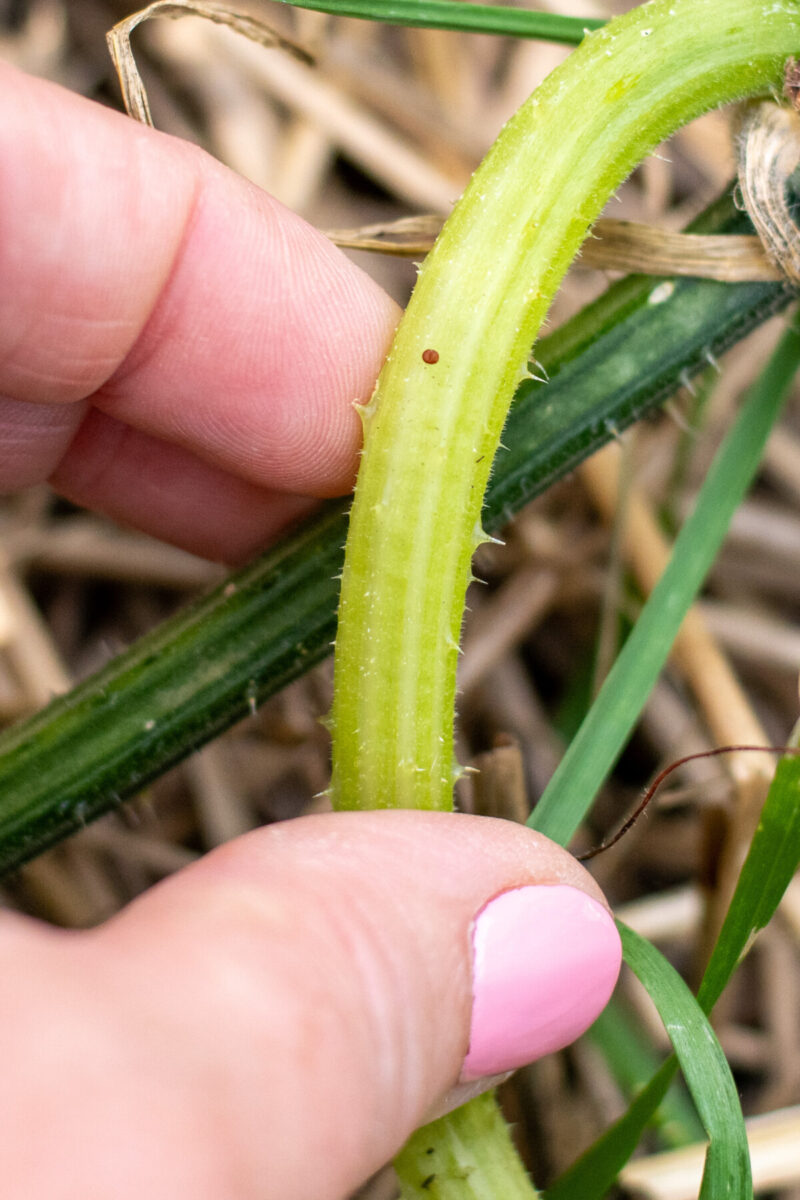
- Timing: Early to mid-summer
- Duration: About 1 week
- Description: Adult female squash vine borers lay eggs on the stems, close to the base of cucurbit plants. The eggs are small, reddish-brown, and typically laid in groups of 6 to 8. Each female moth can lay several batches of eggs during her lifetime.
Larva (Caterpillar) Stage:
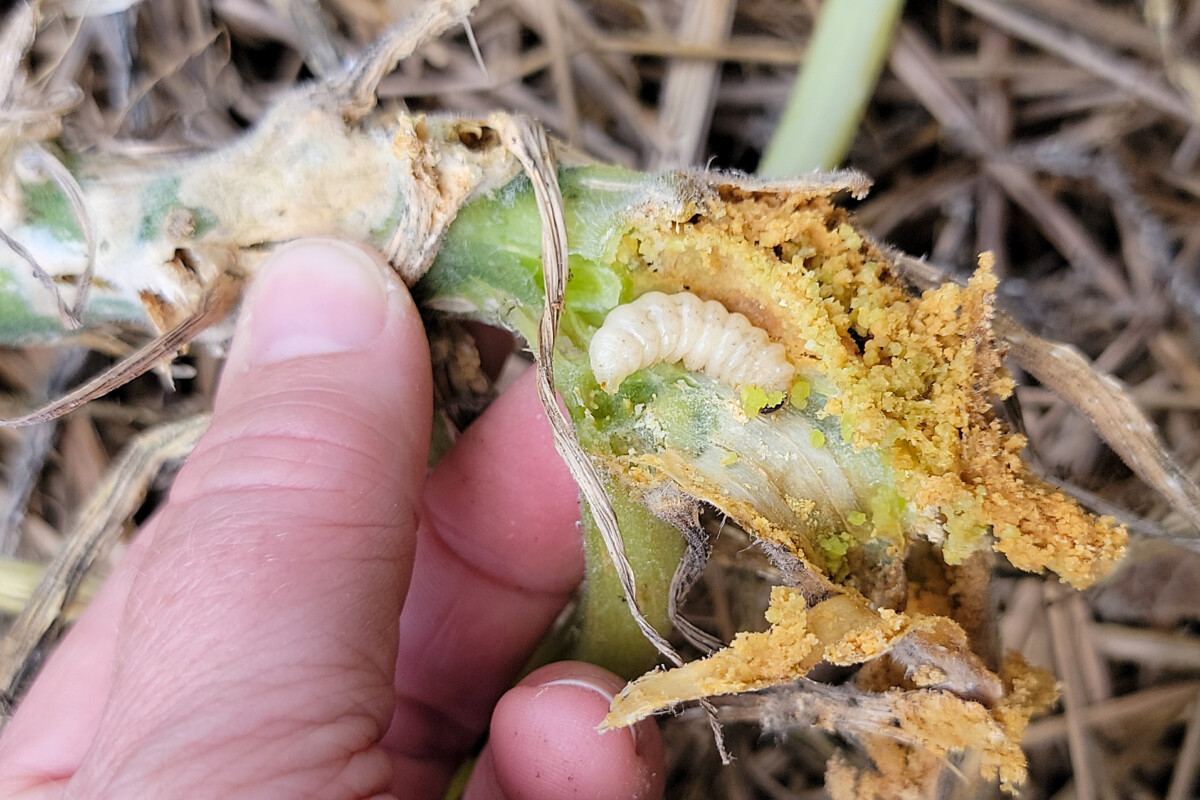
- Timing: Late summer to early fall
- Duration: 3 to 4 weeks
- Description: Once the eggs hatch, the larva emerges and begins to tunnel into the stem of the host plant. The larva is creamy white with a brown head, and it feeds on the inner tissues of the stem. As it feeds, it creates tunnels and chambers within the stem. This feeding can weaken the plant and lead to wilting and dieback.
Pupa Stage:
- Timing: Early fall
- Duration: About 2 to 3 weeks
- Description: After the larval feeding is complete, the larva exits the stem and burrows into the soil to pupate. The pupa is brown, shiny, cylindrical and about an inch long. It remains in the soil through the winter and transforms into an adult moth.
Adult Moth Stage:
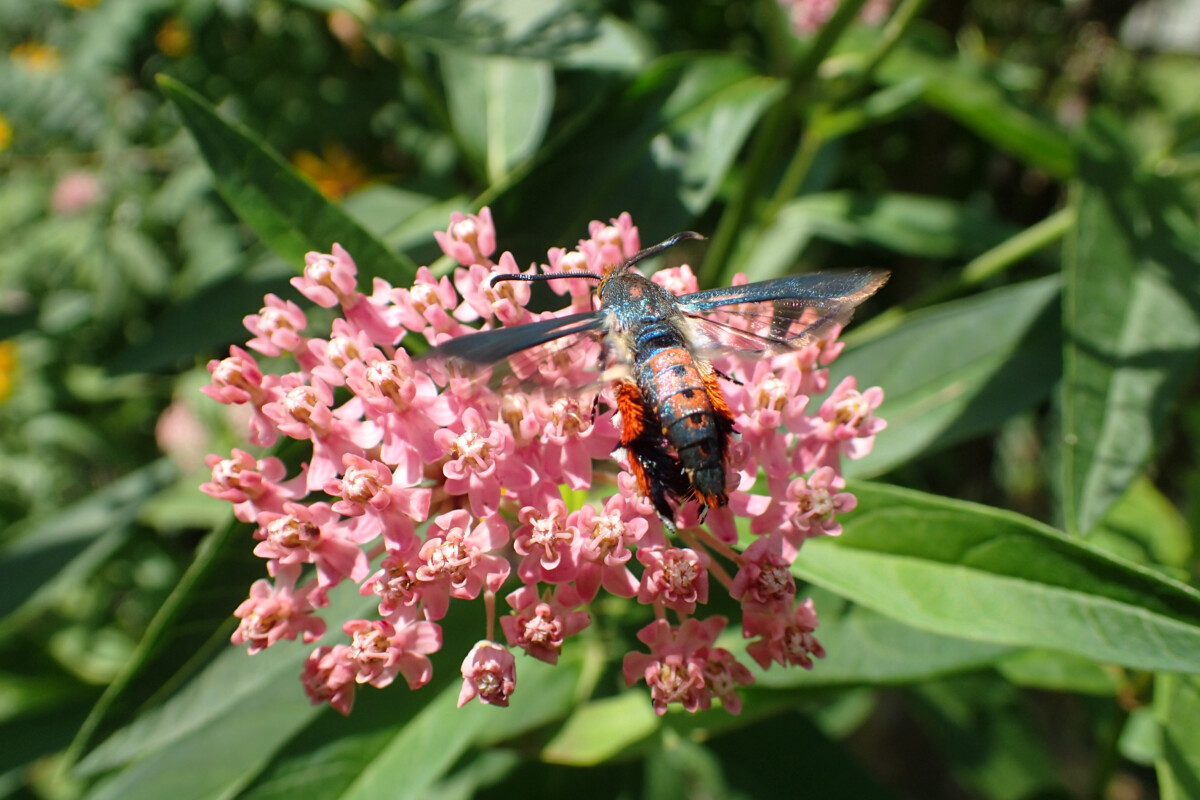
- Timing: Late spring to early summer (typically May to June, depending on the region)
- Duration: 1 to 2 weeks (as adults)
- Description: The adult squash vine borer is a day-flying moth with a metallic green body and orange-black markings. The wings are clear with black edges. It emerges from the pupa in late spring or early summer.
- The adults are active during the day and visit flowers for nectar. Female moths lay eggs on the stems of host plants within an inch or two of soil level.
Damage and Signs of Squash Vine Borers
Is your squash plant looking unwell? It’s probably squash vine borers.
Okay, okay. Keep reading.
Frass – the Tell Tale Marker of Squash Vine Borers
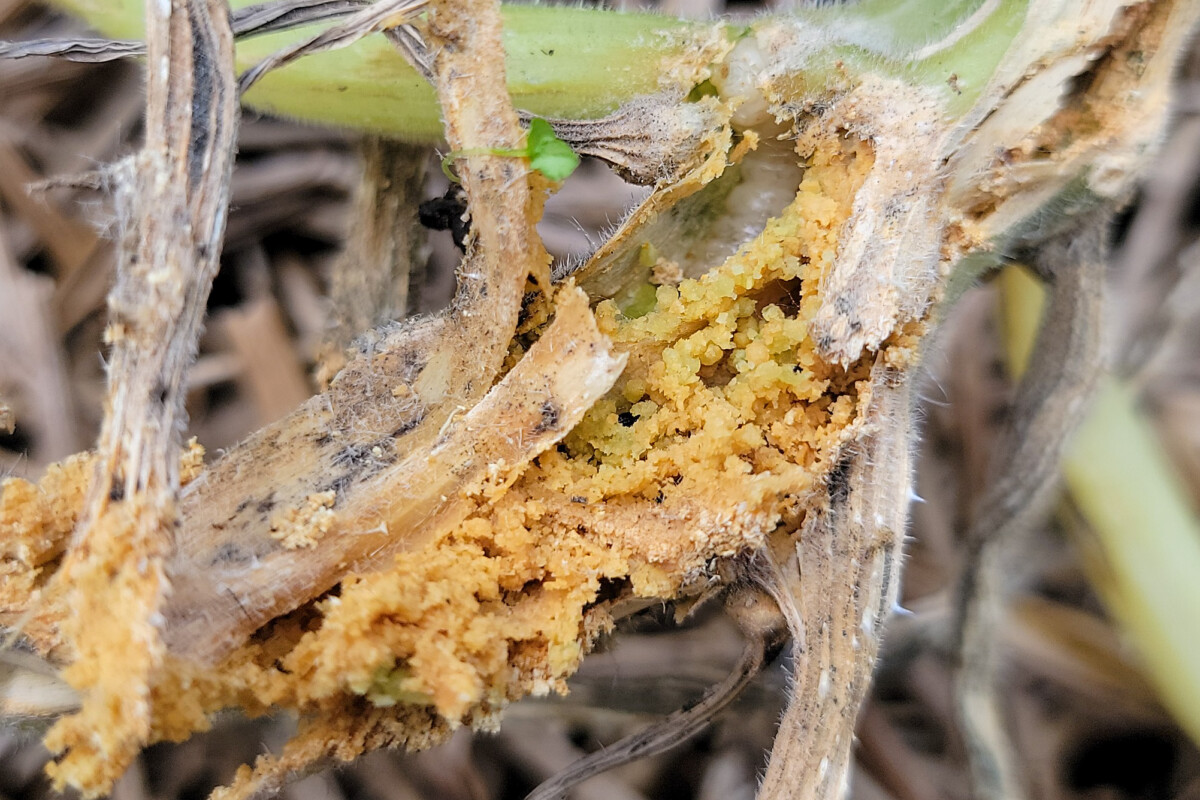
I list this first mainly because it usually accompanies all the other squash vine borer symptoms. Check carefully around the base of the plant and flip some of the vines over. Close to the ground or on the side of the vine resting against the dirt, you will find a pale yellow or light green substance that resembles fine sawdust.
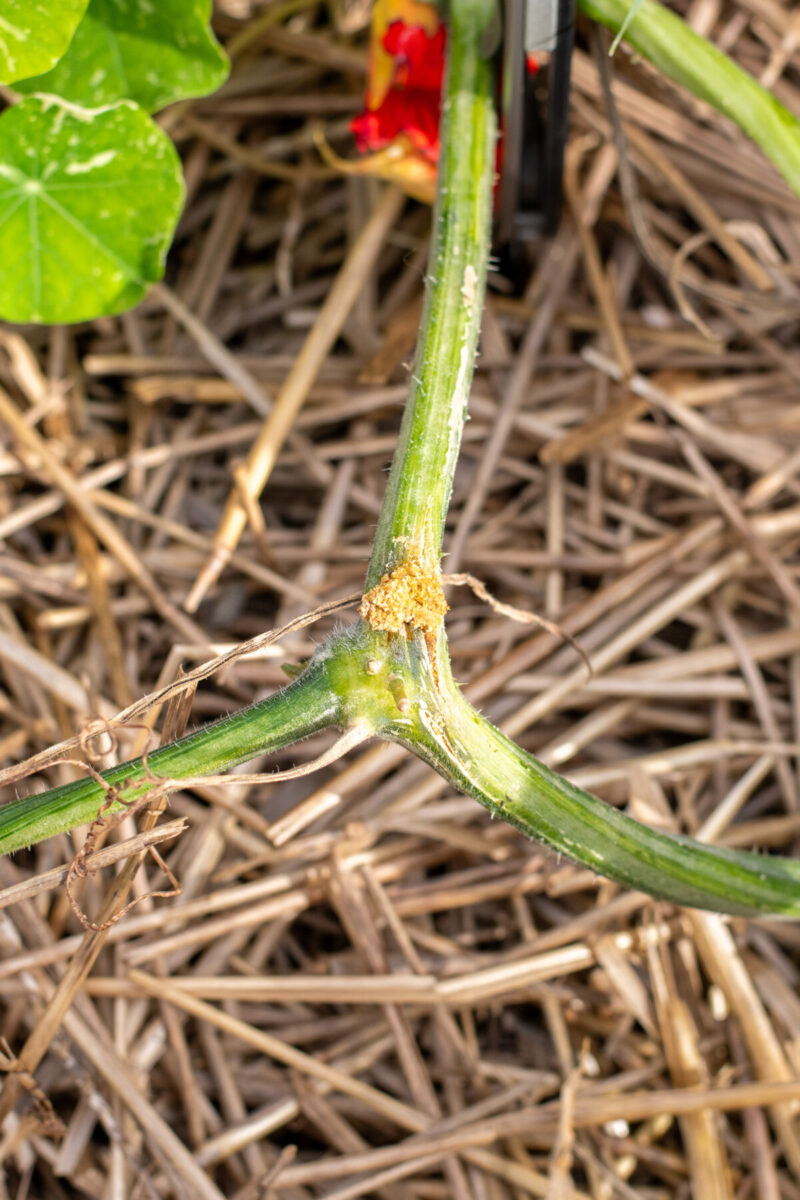
This stuff is called frass, which is a nice way of saying squash vine borer poop. It usually sends gardeners running to Google when they find it on their squash plants. However, if you know what to look for, there are signs of squash vine borers long before you find tiny piles of larva poo.
Wilting Leaves
Wilting leaves are the first sign of squash vine borers. Because they burrow into the stems, the borers damage the plant’s vascular system, which prevents the plant from moving water and essential nutrients out to the vines and leaves, so they wilt.
Yellow Leaves and Discolored Vines
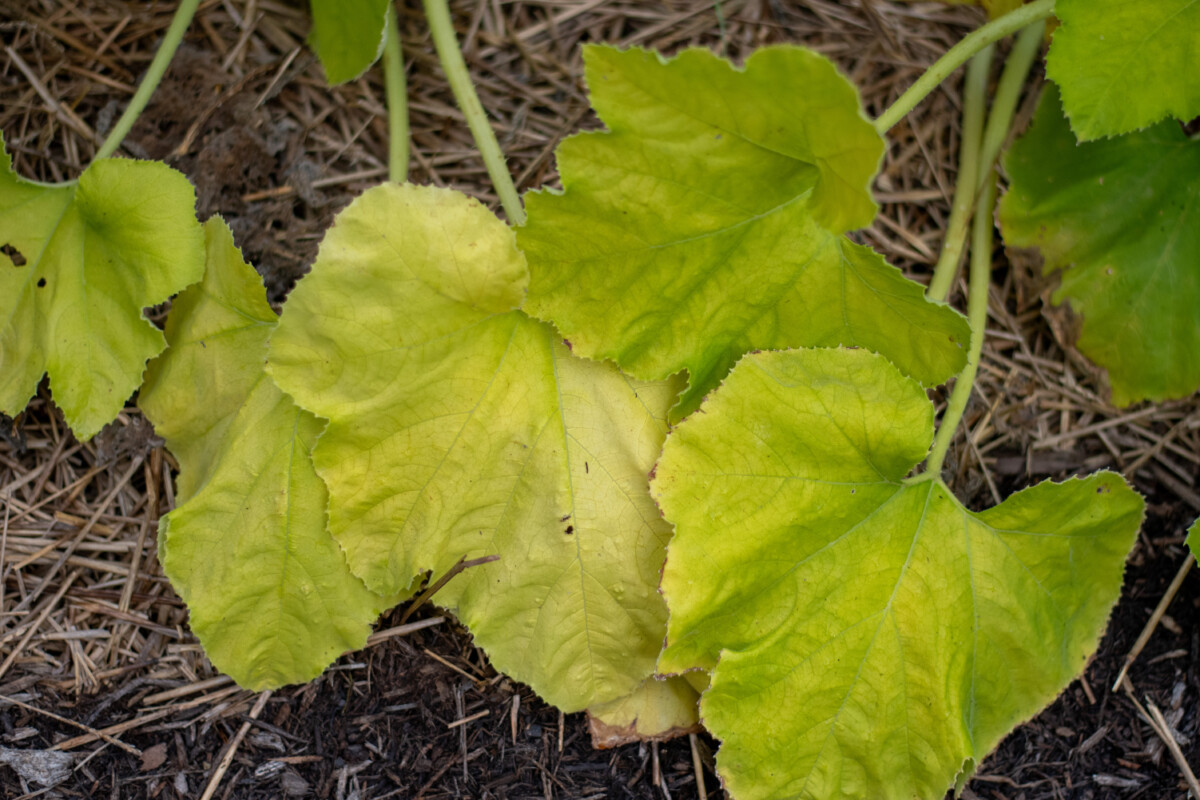
As the squash borers move further into the plant, the leaves will continue to degrade, often turning yellow before dying. You may also notice yellow discoloration of vines and stems as well.
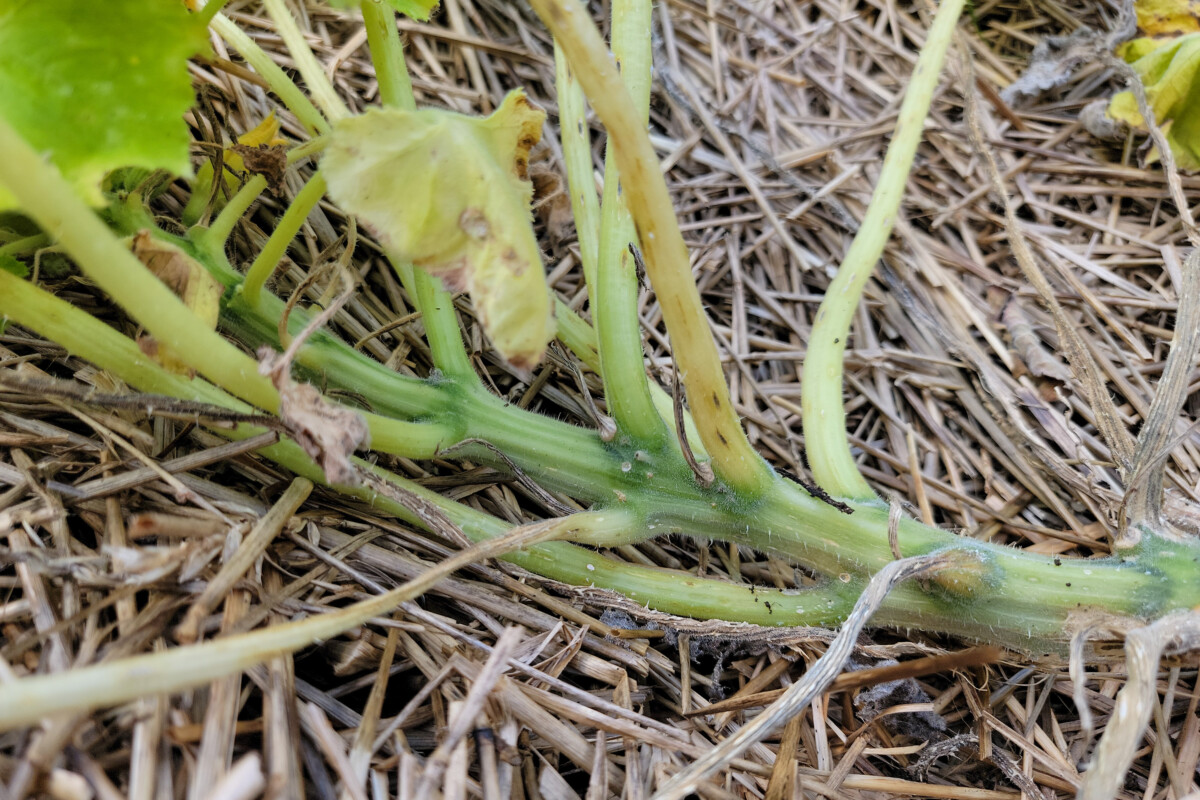
Dying/Dead Leaves From the Center of the Plant Outward
The plant will die from the center out as the borer activity continues. You’ll notice leaves and vines turning brown and dying.
Related Reading: 5 Things Your Zucchini Leaves Are Trying To Tell You
Stems Riddled with Holes/Woody in Appearance
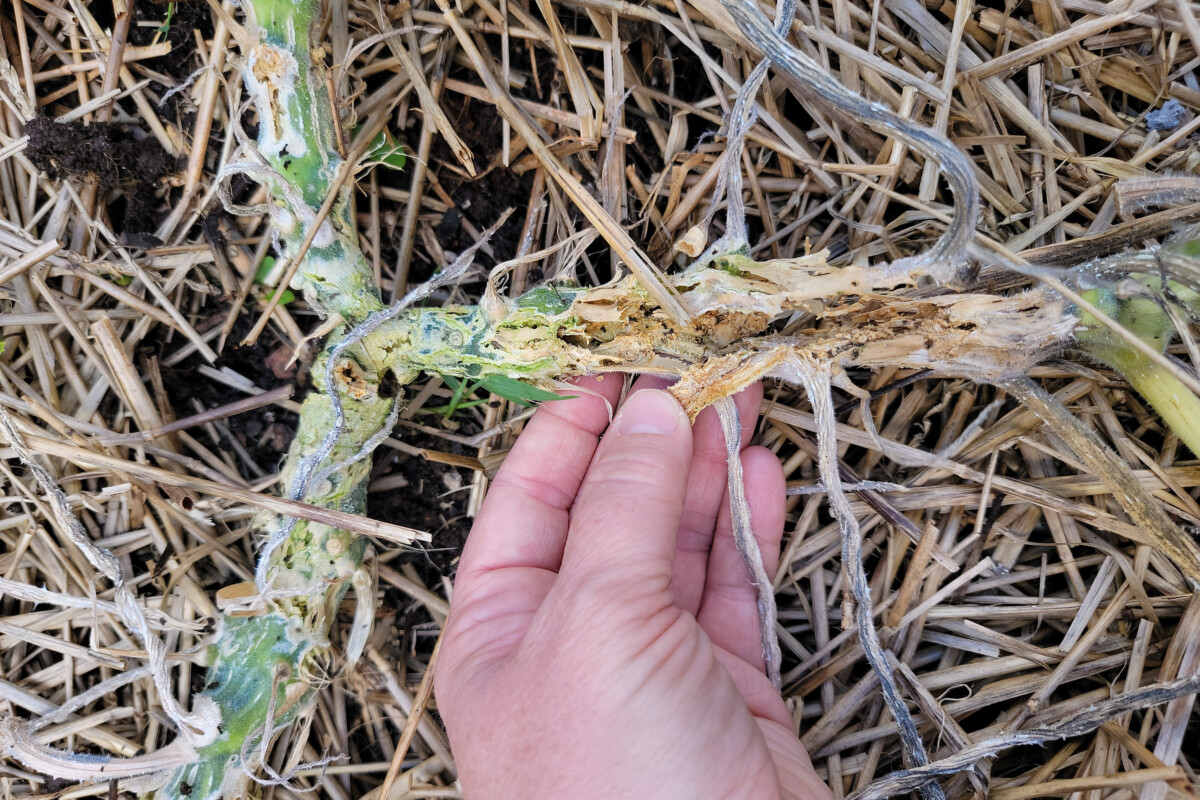
The base of the plant may have holes in it or appear woody; stems are hollowed out and crumbly. At this point, it’s best to proceed directly to this article’s “advanced infestation” portion.
Getting Rid of Squash Vine Borer
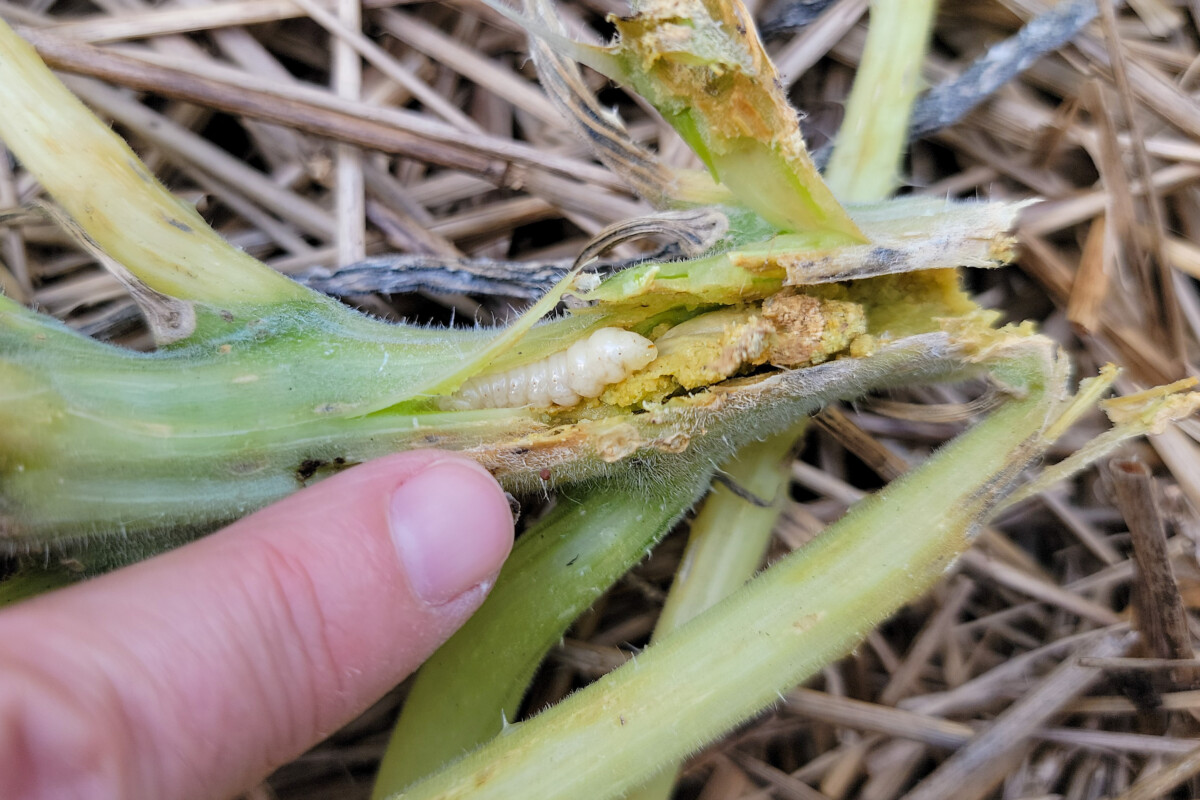
Most of the time, fighting squash vine borer is a losing battle because we manage to find them once our squash is past the point of no return. However, if you pay attention to your plants and find borers at the first sign of a problem (wilting leaves), you can eliminate them with patience and diligence.
To do that, you have to remove the borers from the plant.
There are two methods; I suggest using both as you’ll have a better chance of saving your squash. Perform a search and destroy mission every few days until you no longer find any new larvae in the stems or eggs on the stems. Yes, it’s a lot of work, but it’s the only way to save your squash.
Manually Remove the Larva
Once you know what to look for, finding where a squash borer is hiding out is not hard. Usually, it involves finding frass or the last wilting leaf on a vine before healthy leaves begin growing again. Look for discolored stems as well. Turn the vine over at this node, and you will probably see frass.
Using a clean and sterile knife, slice open the stem to reveal the larva. Often, they will have already chewed a hole in the stem, and you can see them without cutting too far.
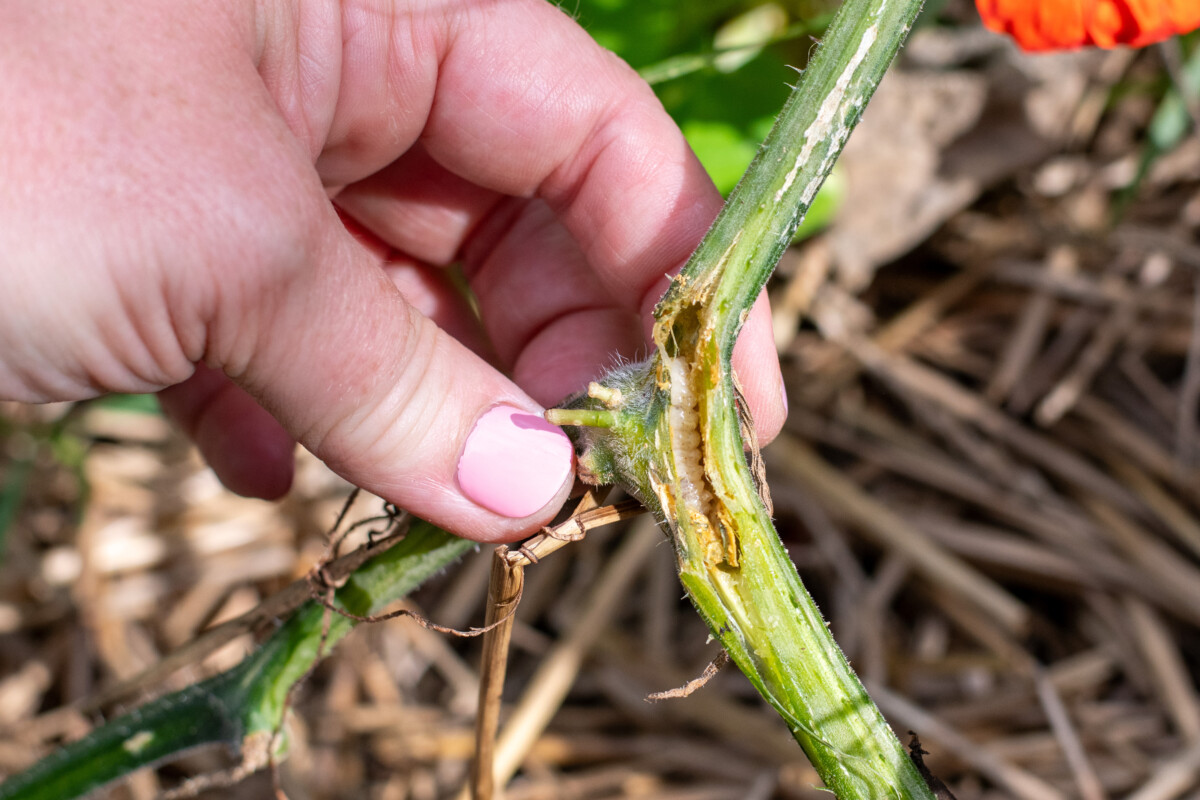
Scoop out the larva, crush it, or pierce it with your knife. Clean your knife each time so you aren’t introducing bacteria throughout the plant.
Bury the cut leaf node a couple of inches below the soil. This will allow the plant to heal and put down new roots, which will help to counteract the vascular damage done by the squash vine borers.
Inject Your Squash Plants with Bacillus thuringiensis
Once you notice you have squash vine borers, you can go on the offensive with Bt. As the borers prefer to burrow at the plant’s base and leaf nodes, inject these sites with Bacillus thuringiensis.
The bacteria paralyze the caterpillar’s digestive tract. Unable to eat, they die off a few days after ingesting the Bt. Due to its effectiveness and because it’s harmless to mammals, birds and other insects, it’s one of the most popular organic biological methods of pest control in the world and available to purchase cheaply here on Amazon.
You can pick up hypodermic syringes at your local feed store or big box agriculture supply stores such as Tractor Supply and Rural King.
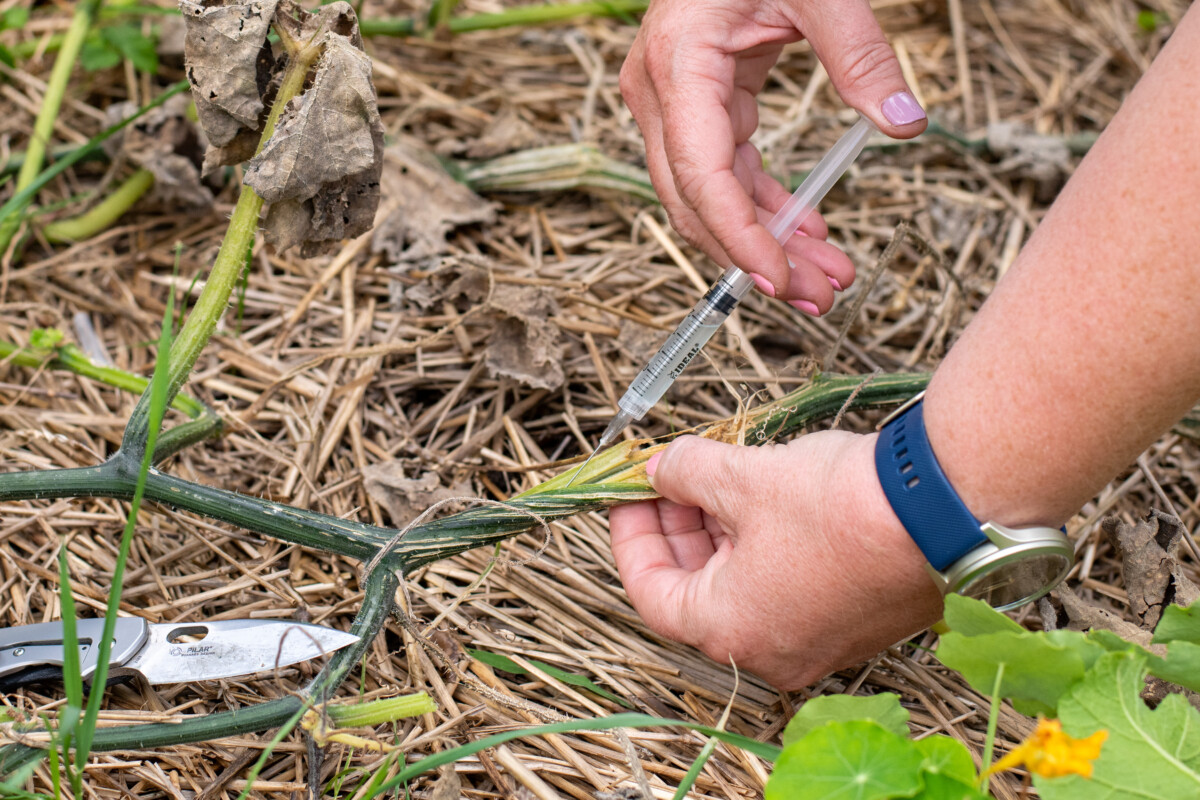
Mix the Bt according to the instructions on the package and fill your syringe with the solution. Inject approximately one cc/ml into each joint and the base of the stem. Repeat this process once a week until you’ve killed off the borers.
Advanced Squash Vine Borer Infestations
The best thing you can do with an advanced infestation is to rip up all your squash plants and burn them. The sooner, the better. You’ll destroy the larva still hanging out in the vines and stems of the plant before they have a chance to move into the soil.
If you end up with a bad infestation, turning the soil at the end of the season where you grew squash is a good idea. Once mature, the larva will pupate in the soil over winter. Turning the soil will kill any pupa hanging out in it. I suggest turning the soil at least twice, a few days apart, to ensure all squash vine borer pupa are unearthed and dry out.
Squash Vine Borer Prevention
You’re probably sick of hearing it, especially amid an all-out battle against squash vine borers and way past the point of prevention, but pest prevention is the best way to deal with pests. This information will save you a lot of trouble when the next growing season rolls around, so you can actually have a squash harvest rather than a squashed harvest.
Wrapped for Freshness
The female moth lays eggs a mere inch or so above soil level on the stems of your favorite cucurbits. You can easily prevent her from doing so with something you already have in one of your kitchen drawers – aluminum foil.
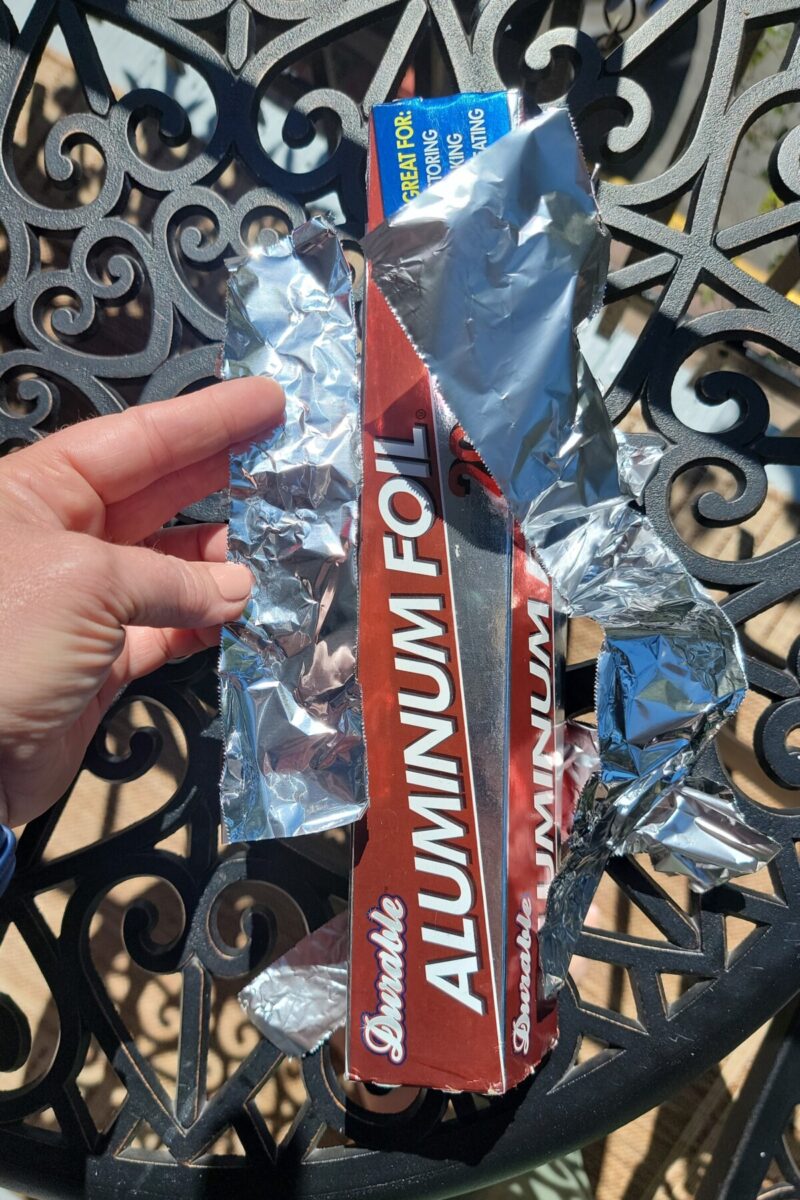
When it’s time to transplant your squash outdoors, use thin strips of aluminum foil and wrap them loosely around the base of the stem of your squash plant. Start wrapping just below soil level and continue up the stem about six inches. Remember, keep the aluminum foil loose to allow the stem to grow.
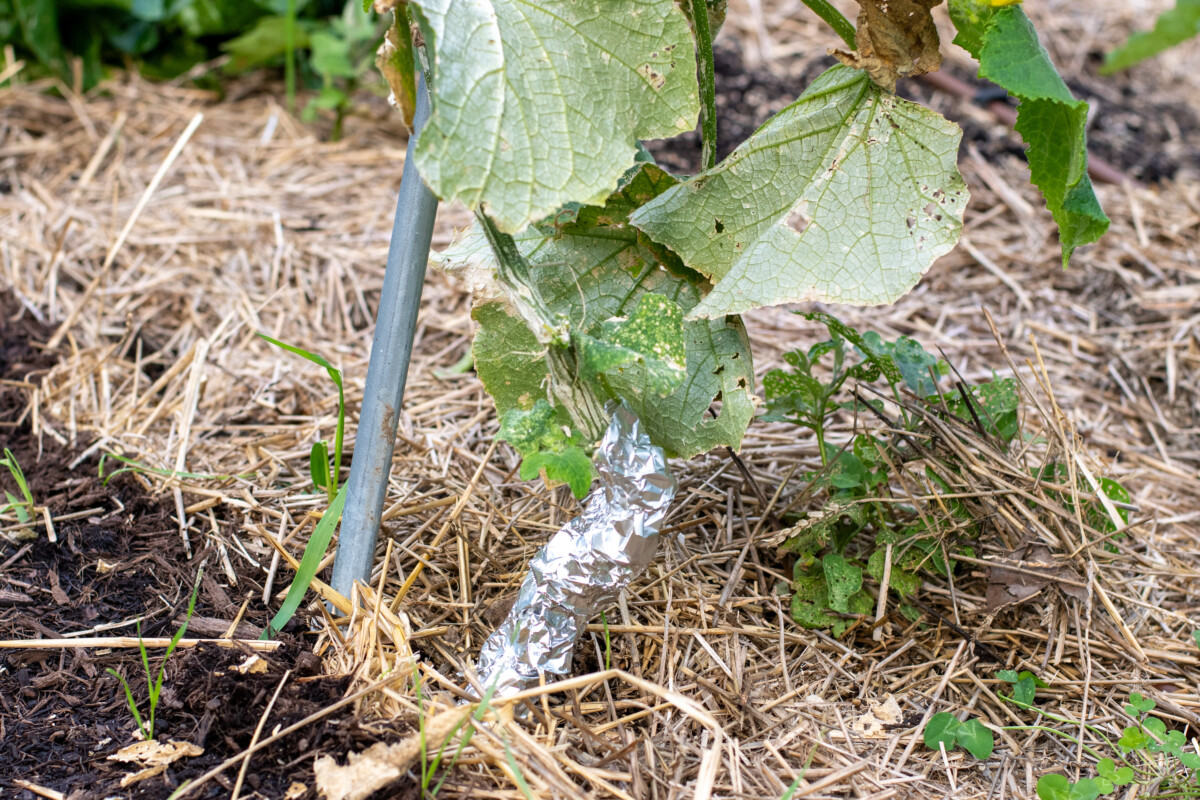
Dig down into the soil a little bit to cover the stem below the soil level with foil. Then, push the soil around the bottom of the wrapped stem.
Along with wrapping the base, growing and staking your zucchini and other summer squash vertically can help prevent squash vine borers and things like powdery mildew.
Make Sure Your Squash is Up to Date on Its Shots
Another great way to prevent squash vine borer infestations is to inoculate your squash plants with Bt when the moths are active. Check with your local county extension office (you can use this interactive map to find yours) to find out when squash vine borer moths are active in your area and begin injecting the stem and the base of leaves with Bt.
This is much easier to do as a preventative as the plant will be much smaller when the moths are actively laying eggs. Using the same method described earlier in the article, inoculate each leaf stem and the base of your plant with Bt once a week while moths are laying eggs. (Again, check with your county extension office.)
Inspect Plants for Eggs
Wrapping the stems and inoculating with Bt is usually enough to keep squash vine borers from getting a foothold in your garden, but it’s always a good idea to check your plants for signs of pests. Look for singular brown dots on your squash stems and vines close to the ground. Scrape them off with your fingernail as you find them.
Crop Rotation
Beyond replenishing nutrients used by different plants, crop rotation is an important tool in preventing recurring pest problems. Many pests winter over in the soil, including the squash vine borer. Moving where you plant your squash can help prevent another infestation, especially if you have tilled up the area where you planted squash the previous year.
Two Things That Don’t Work
Covering your plants rarely works, as the moths are often active around the time your squash plants start producing flowers. Unless you plan on hand-pollinating your squash all season long, you’ll need to uncover your plants. If you have pupa in the soil from the previous year, you’re just trapping any emerging moths in with your squash.
Spraying Bt on the plant rarely works as you need to coincide spraying with the small time window when the larva emerges from the egg and burrows into the stem.
After reading this article, I hope you’ll put these practices in place and never have to lose out on a season of delicious squash again. Oh, and if the whole squash bug thing is still bothering you, I’ve written an article on how to deal with them as well.

Get the famous Rural Sprout newsletter delivered to your inbox.
Join the 50,000+ gardeners who get timely gardening tutorials, tips and tasks delivered direct to their inbox.


